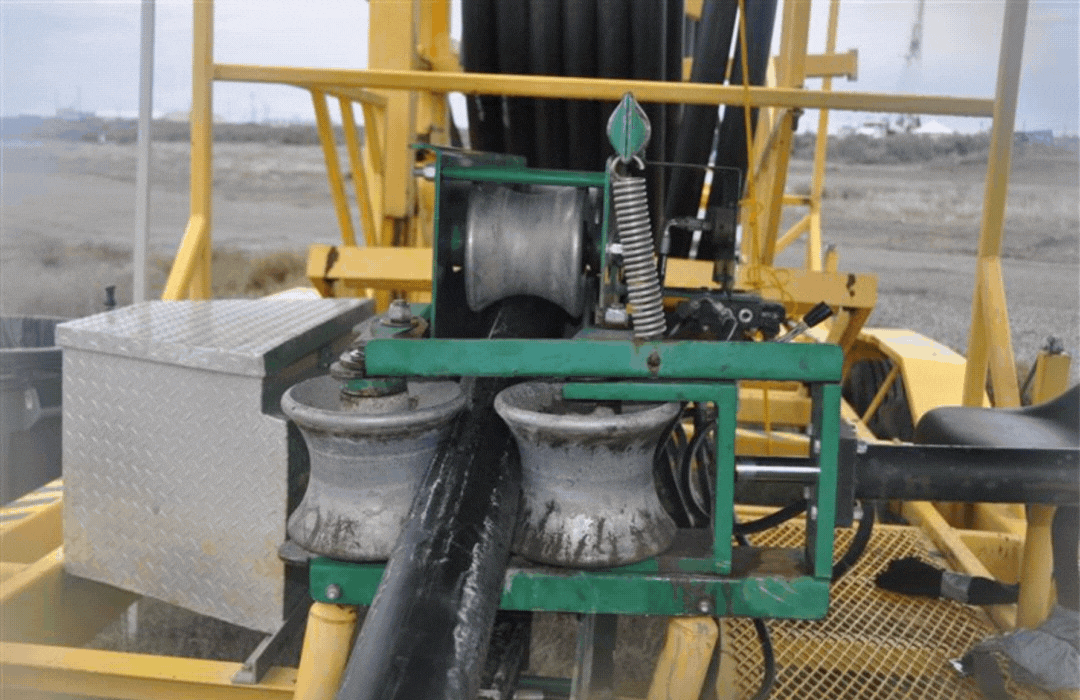EM construction crews at the Hanford Site are laying it on the line — literally — to expand the treatment capacity of the site’s already robust groundwater cleanup program.
Office of Environmental Management
March 5, 2024
Workers with EM contractor Central Plateau Cleanup Company are installing piping to expand the Hanford Site’s groundwater treatment network. They use a specialized machine to straighten hundreds of feet of coiled piping and reduce the number of connections, significantly improving efficiency in the field.
RICHLAND, Wash. — EM construction crews at the Hanford Site are laying it on the line — literally — to expand the treatment capacity of the site’s already robust groundwater cleanup program.
The expansion project by contractor Central Plateau Cleanup Company requires the installation of 54,000 feet — more than 10 miles — of specialized plastic piping to connect the 200 West Pump and Treat Facility, Hanford’s largest groundwater treatment plant, to about a dozen new groundwater extraction wells. The expanded network of wells will increase the capacity of the treatment facility from 2,500 to 3,400 gallons per minute to capture more chemical and radiological contaminants from the groundwater under the site’s Central Plateau.
The original approach to installing the piping involved placing and connecting each 40-foot section individually, a labor-intensive endeavor. Enter the Line Tamer, a machine that straightens hundreds of feet of coiled pipe at a time and reduces the number of connections, significantly expediting installation. To date, crews have installed more than 26,000 feet of the piping using the machine.
“The use of this specialized equipment is another example of our award winning groundwater team finding and implementing an innovative and cost effective solution to boost our treatment efforts,” said Naomi Jaschke, project director for Hanford’s soil and groundwater division. “Expanding the capacity of our largest treatment facility will potentially reduce costs and shorten the time needed to meet cleanup goals, with protection of the Columbia River our ultimate mission.”
The 200 West facility is one of Hanford’s six pump-and-treat systems, with five smaller facilities located along the Columbia River. Collectively, the systems have treated more than 2 billion gallons of contaminated groundwater annually for nine consecutive years, with crews on track to make it a decade in fiscal year 2024, which ends Sept. 30.
Currently the 200 West facility alone treats more than 1 billion gallons of groundwater each year on the Central Plateau. Expansion of the system will allow for as much as 650 million additional gallons of groundwater to be treated annually.
The extraction wells pump contaminated water from the aquifer, which can be up to 200 feet below the surface in some areas. The water moves through the system, which removes contaminants using specialized resins, air stripping and granular activated carbon. The treated water is then injected back into the ground and helps push untreated groundwater toward the extraction wells, continuing the cycle.
“Our team expects to begin connecting to some of the extraction wells this month, with construction and installation of the new pipelines completed later this spring, a significant acceleration over the initial plan,” said Bill Barrett, Central Plateau Cleanup Company’s chief operating officer. “I’m proud of our continued focus and commitment to finding efficiencies in cost and schedule as we advance this critical expansion effort.”
The full expansion project is expected to be completed by September.
To receive the latest news and updates about the Office of Environment Management, submit your e-mail address.

